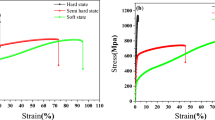Abstract
In this paper, the prestressed multilayer stagger-split die (PMSSD), which is a kind of high-pressure device, is studied by numerical simulation, theoretical analysis, and experiments. The force characteristics, failure mechanism, and failure mode of the belt die and PMSSD are studied. The results show that the failure of the belt die is caused by the tensile stress, while the PMSSD is caused by the von Mises stress. According to the stress characteristic, the PMSSD has higher pressure bearing capacity. The experimental results demonstrate that the PMSSD has higher pressure bearing capacity compared with the theoretical analysis. This provides a method for designing higher-pressure dies.










Similar content being viewed by others
References
P. W. Bridgman, The resistance of 72 elements, alloys and compounds to 100,000 kg/cm2. Papers 169–199 (Harvard University Press, 1964), pp. 4113–4197
H.T. Hall, Ultra-high-pressure, high-temperature apparatus: the “Belt.” Rev. Sci. Instrum. 31(2), 125–131 (1960)
H.T. Hall, Some high-pressure, high-temperature apparatus design considerations: Equipment for use at 100,000 atmospheres and 3000 C. Rev. Sci. Instrum. 29(4), 267–275 (1958)
H.T. Hall, High pressure apparatus: ram-in-tie-bar multianvil presses. Rev. Phys. Chem. Jpn. 37(2), 63–71 (1967)
N. Kawai, S. Endo, The generation of ultrahigh hydrostatic pressures by a split sphere apparatus. Rev. Sci. Instrum. 41(8), 1178–1181 (1970)
B. Xu, Y. Tian, Superhard materials: recent research progress and prospects. Sci. China Mater. 58(2), 132–142 (2015)
L. Zhao, M. Li, R. Li et al., Stress analysis of the multi-layer stagger-split die for synthesizing gem quality large single crystal diamond. Diam. Relat. Mater. 83, 54–59 (2018)
Y. Yang, M. Li, B. Wang, Study on stress distribution of tangent split high pressure apparatus and its pressure bearing capacity. Diam. Relat. Mater. 58, 180–184 (2015)
W.A. Bassett, Diamond anvil cell, 50th birthday. High Press. Res. 29(2), 163–186 (2009)
R.C. Liebermann, Multi-anvil, high pressure apparatus: a half-century of development and progress. High Press. Res. 31(4), 493–532 (2011)
J.A. Xu, H.K. Mao, P.M. Bell, High-pressure ruby and diamond fluorescence: observations at 0.21 to 0.55 terapascal. Science. 232(4756), 1404–1406 (1986)
T. Katsura, K. Funakoshi, A. Kubo et al., A large-volume high-pressure and high-temperature apparatus for in situ x-ray observation, ‘SPEED-Mk. II.’ Phys. Earth Planet. Inter. 143, 497–506 (2004)
Y. Ichida, H. Ohfuji, T. Irifune et al., Synthesis of coarse-grain-dispersed nano-polycrystalline cubic boron nitride by direct transformation under ultrahigh pressure. Diam. Relat. Mater. 77, 25–34 (2017)
W. Qiang, H. Fang, L. Wei et al., Strength analysis and optimization for both the cylinder and the anvil of a BELT-type ultra-high-pressure apparatus by FEM. J. Mater. Process. Technol. 55(1), 5–10 (1995)
Z. Yi, W. Fu, M. Li et al., Numerical simulation and experimental verification of a novel double-layered split die for high-pressure apparatus used for synthesizing superhard materials. Int. J. Miner. Metall. Mater. 26, 377–385 (2019)
W.C. Moss, K.A. Goettel, The stability of a sample in a diamond anvil cell. J. Appl. Phys. 61(11), 4951–4954 (1987)
J. Vrbka, Z. Knesl Z, Proceedings of high pressure geoscience and material synthesis, p. 234 (1988)
X. Y. Liu, High pressure synthesis and preparation of inorganic materials, in Modern Inorganic Synthetic Chemistry (Elsevier, 2017), pp. 105–141
J. Vrbka, Z. Knésl Z, Philosophy and reality of strength design of the BELT chamber by finite element method. In: Proceedings of high pressure geoscience and material synthesis, (Akademie-Verlag, Berlin, 1988), pp. 234–239
B. Wang, L.I. Mingzhe, Z. Liu et al., A novel tangential split-belt ultrahigh pressure apparatus. Gaoya Wuli Xuebao/Chin. J. High Press. Phys. 33(01), 64–69 (2019)
T. Klünsner, S. Wurster, P. Supancic et al., Effect of specimen size on the tensile strength of WC–Co hard metal. Acta Mater. 59(10), 4244–4252 (2011). https://doi.org/10.1016/j.actamat.2011.03.049
B. Wang, M. Li, Z. Liu et al., Numerical simulation and experiment on new multilayer stagger-split die of ultra-high pressure apparatus. Gaoya Wuli Xuebao/Chin. J. High Press. Phys. 32(06), 27–32 (2018)
E.C. Robertson, Experimental study of the strength of rocks. Bull. Geol. Soc. Am. 66(10), 1275 (1955)
G. Cook, The yield point and initial stages of plastic strain in mild steel subjected to uniform and non-uniform stress distributions. Philos. Trans. R. Soc. Lond. Ser. A Contain. Papers Math. Phys. Character. 230(681–693), 103–147 (1931)
B. Crossland, J.A. Bones, Behaviour of thick-walled steel cylinders subjected to internal pressure. Proc. Inst. Mech. Eng. 172(1), 777–804 (1958)
Acknowledgments
This work was supported by the National Key Research and Development Program of China (2021YFD2000502), the Shandong Province Technology Innovation Capability Enhancement Project (2023TSGC0536), and the Key Research and Development Program of Rizhao (2023ZDYF010114).
Author information
Authors and Affiliations
Corresponding author
Additional information
Publisher's Note
Springer Nature remains neutral with regard to jurisdictional claims in published maps and institutional affiliations.
Rights and permissions
Springer Nature or its licensor (e.g. a society or other partner) holds exclusive rights to this article under a publishing agreement with the author(s) or other rightsholder(s); author self-archiving of the accepted manuscript version of this article is solely governed by the terms of such publishing agreement and applicable law.
About this article
Cite this article
Shi, Z., Wang, B. & Li, M. Research on the Mechanical Characteristics and Failure Mechanism of Prestressed Multilayer Stagger-Split Die. J Fail. Anal. and Preven. 23, 2370–2377 (2023). https://doi.org/10.1007/s11668-023-01761-1
Received:
Revised:
Accepted:
Published:
Issue Date:
DOI: https://doi.org/10.1007/s11668-023-01761-1



